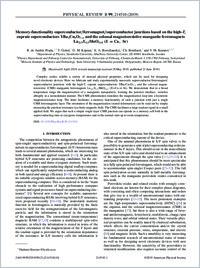Memory-functionality superconductor/ferromagnet/superconductor junctions based on the high- T c cuprate superconductors YBa 2 Cu 3 O 7 − x and the colossal magnetoresistive manganite ferromagnets La 2 / 3 X 1 / 3 MnO 3 + δ ( X = Ca , Sr )
- Andrés Prada, R. de Department of Physics, Stockholm University, AlbaNova University Center, Stockholm, Sweden - Physics Department and Fribourg Center for Nanomaterials, University of Fribourg, Switzerland
- Golod, T. Department of Physics, Stockholm University, AlbaNova University Center, Stockholm, Sweden
- Kapran, O. M. Department of Physics, Stockholm University, AlbaNova University Center, Stockholm, Sweden
- Borodianskyi, E. A. Department of Physics, Stockholm University, AlbaNova University Center, Stockholm, Sweden
- Bernhard, Christian Physics Department and Fribourg Center for Nanomaterials, University of Fribourg, Switzerland
- Krasnov, V. M. Department of Physics, Stockholm University, AlbaNova University Center, Stockholm, Sweden - Moscow Institute of Physics and Technology, State University, Dolgoprudny, Russia
-
21.06.2019
Published in:
- Physical Review B. - 2019, vol. 99, no. 21, p. 214510
English
Complex oxides exhibit a variety of unusual physical properties, which can be used for designing novel electronic devices. Here we fabricate and study experimentally nanoscale superconductor/ferromagnet/superconductor junctions with the high-Tc cuprate superconductors YBa2Cu3O7−x and the colossal magnetoresistive (CMR) manganite ferromagnets La2/3X1/3MnO3+δ (X=Ca or Sr). We demonstrate that in a broad temperature range the magnetization of a manganite nanoparticle, forming the junction interface, switches abruptly in a monodomain manner. The CMR phenomenon translates the magnetization loop into a hysteretic magnetoresistance loop. The latter facilitates a memory functionality of such a junction with just a single CMR ferromagnetic layer. The orientation of the magnetization (stored information) can be read out by simply measuring the junction resistance in a finite magnetic field. The CMR facilitates a large readout signal in a small applied field. We argue that such a simple single-layer CMR junction can operate as a memory cell both in the superconducting state at cryogenic temperatures and in the normal state up to room temperature.
- Faculty
- Faculté des sciences et de médecine
- Department
- Département de Physique
- Language
-
- English
- Classification
- Physics
- License
- License undefined
- Identifiers
-
- RERO DOC 327009
- DOI 10.1103/PhysRevB.99.214510
- Persistent URL
- https://folia.unifr.ch/unifr/documents/308049
Statistics
Document views: 77
File downloads:
- ber_mfs.pdf: 181
